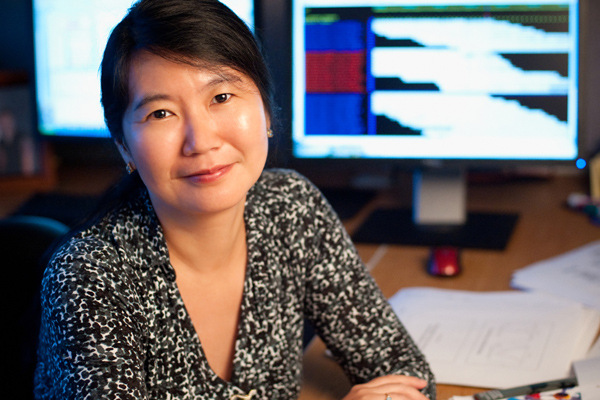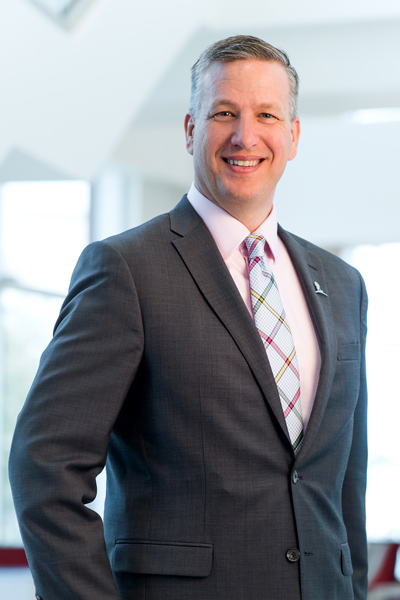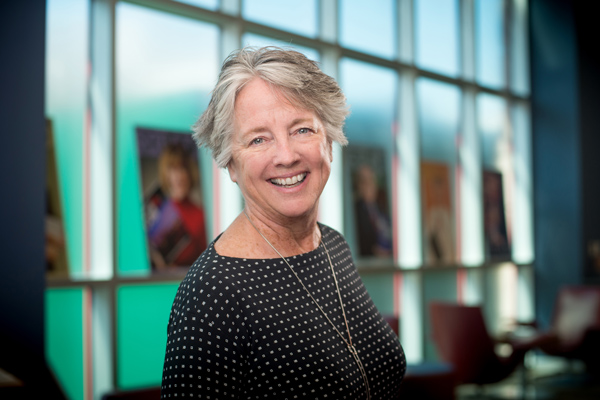Lush greenery, beautiful sculptures, brightly colored modern buildings. There’s a palpable dedication to making every element of St. Jude Children’s Research Hospital focused on the children it serves. It made an impression on Keith Perry the moment he set foot on campus. “I called my wife and told her she just needed to come see this place,” Perry, St. Jude’s senior vice president and CIO, recalls. “It’s the passion that people here have, the mission of finding cures and saving children, and the holistic approach to bringing science to help speed recovery for pediatric patients.”
When he sees a family or a young child on St. Jude’s campus, Perry explains, it’s because of a catastrophic disease that has upended their lives. And when he sees another team member, he knows they have dedicated themselves to improving the lives of others. That passion informs everything at St. Jude’s, resulting in a comprehensive experience for patients. The team doesn’t just offer world-class treatment for its young patients. It goes as far as flying patients and their families to the Memphis campus, picking them up from the airport, providing them housing, feeding them, and more—all without sending a bill to the patient’s family.

“We’ll bill insurance up to a point, but they’re not going to pay out-of-pocket,” Perry says. Moreover, none of that would be possible without every person in the organization believing in the organization’s mission. Of course, putting all of the various pieces together and making them work relies on technological expertise as well.
Impact on Patient Experience
“Poor IT, I just keep hitting them with different things,” says St. Jude’s director of patient and family experience Janice English. “Technology is such a big piece of everything we do, and it is getting larger every single day.” Perry and his team face all of the traditional challenges of CIOs in the healthcare world. These of course include electronic medical records, cybersecurity, and data storage. But that dedication to excellent, comprehensive patient experiences provides St. Jude with its fair share of unique challenges.
For example, St. Jude wants to provide patients’ families with the freedoms that they might have at home. That’s especially important because some have flown to the hospital from across the country. The team has partnered with Zipcar so parents can take their families to the grocery store or on day trips. These outings help provide them some normalcy that makes all the difference in the midst of intensive treatment. “Zipcar graciously agreed to work out some special considerations for our families,” English explains. There are now two Zipcars stationed on campus. From a tech standpoint, this required building out a registration and reservation process. However, Zipcar waived some fees and the technology team put in the work to make it happen.
The Need for Many Tools
Zipcars, however, are just one small aspect of the comprehensive patient experience—which itself calls for a comprehensive set of tools. As a former accountant who transitioned into healthcare as a nurse, English approaches patient experience from a unique perspective. She isn’t afraid of dreaming big to deliver the best. English’s department has partnered with Perry’s team to produce an app that provides patients and their families with all the information they need. This would help guide families from the time they are accepted to be a St. Jude family to their first step on campus. It’s a lot of information and unique logistics, but the St. Jude team has the innovative minds and collaborative spirit to make it happen.
“The diagnosis can be a scary thing, and we will do anything we can do to decrease that anxiety . . . We are blessed because we are able to do this work.”
First and foremost, the app must provide detailed information to families that have never been to Memphis, Tennessee—and even more to those that might have never flown on a plane. It needs to detail how to deal with TSA when transporting a sick child, where the family will stay in Memphis, how to move from appointment to appointment, where to catch shuttles, when meals will be available, and more. “They’ve never had the stress of having to deal with that initial diagnosis and the fact that they’re even coming to St. Jude to begin with, so we do what we can to eliminate that stress along that pathway,” Perry says.

The first version of the app is scheduled for a January launch. English is already envisioning the layers that can add even further benefit to patients and their families—including helping track legal and medical paperwork, advising what to pack for the journey, and introducing patients to their care team. The hospital’s Family Advisory Council has been thrilled by prototypes, and the whole team is excited for what might come next. “The diagnosis can be a scary thing, and we will do anything we can do to decrease that anxiety and make this a little less scary for the parents and the kids,” English says. “Anything we can do to make the environment better—make their general stay here better—that’s what we’re all looking for.”
The Need to Collaborate with Science
But St. Jude’s commitment to bettering the lives of patients goes far beyond making treatment easier. Dr. Jinghui Zhang, chair of the computational biology department, joined the organization and set up the genomic analysis infrastructure. Zhang aimed to better understand the diseases the patients face and learn about potential new treatments. She too must collaborate across functions to develop new processes and technologies. As a prime example, she recently collaborated with the chair of the department of epidemiology and cancer control, Dr. Leslie Robison. Together, they initiated a genomic study that assessed whether inherited genetic mutation can link to a second occurrence of cancer and to look at other genotypes related to the survivors of childhood cancer.
“The work we presented was the first study utilizing the whole genome sequencing data generated from these three thousand childhood cancer survivors,” Zhang explains. “We found that childhood cancer survivors with genetic mutation have an elevated risk for secondary cancer, including breast cancer, sarcoma, and thyroid cancer, both for patients treated with radiation therapy and those not on radiation therapy. That has a lot of implications regarding the treatment for the new patients and how we provide genetic surveillance and counseling to the families of childhood cancer patients.”

Groundbreaking studies require a lot of data, something which in turn requires sophisticated storage capabilities. For that reason, Perry, Zhang, and their teams have worked together to develop St. Jude’s cloud. On top of helping to store all of the genomic data that St. Jude generates and collects, the cloud will help streamline sharing that information with the research community.
Moving large amounts of data in genomic files around is incredibly challenging. Both the time it takes to move the data and validating it once it’s been moved present challenges. “Then you have to have the computational capacity to process that data based upon your ideas and your knowledge of your research,” Perry says. “We’re trying to break down some of those barriers. We want to bring the community to the data instead of the community taking the data from us. Cloud storage and computing should help democratize that process and could uncover unexpected discoveries.”
Sharing the Data Wealth
Zhang has also worked to develop and publish tools for other researchers and institutions to use when analyzing the massive amounts of data. However,
because they are so complex, her team was using valuable hours just helping to install and teach these tools. Together with Perry, they worked to put the tools on the cloud to alleviate the burden of support.
Together, Zhang and Perry have also identified and evaluated commercial partners to help facilitate these efforts. They hope all this work will eventually lead to a series of articles in high-impact journals that utilize the genomic data generated by St. Jude. They also see its potential as a sort of training ground for data analysts in general, rather than just for cancer researchers. “We believe that the genomic data generated by St. Jude is one of the highest quality data sets to exist in the world,” Zhang says. “People who are interested in developing novel computational methods can use our data set as training data to verify their algorithms. We will gain novel analytical tools based on the exploration of the data we made available.”
But, ultimately, everything done at St. Jude works toward fighting diseases like pediatric cancer. “If we discover something in one patient, that might not be sufficient to declare this as a significant finding, but if we can enable the global research community to combine our data with other in-house data, their patient cohort will raise the significance of our finding,” Zhang says. Sharing and integrating St. Jude’s data with that of other researchers could make for impactful findings in pediatric cancer worldwide.
Building to the Future
Although there are other institutions joined in the fight to find a cure to pediatric cancer, no hospital does so with the unifying passion and strength of St. Jude. They face many challenges and long odds in that fight, but St. Jude’s professionals always approach those challenges in a way that takes into consideration the institution’s young patients. From the doctors themselves to the technology team, everyone understands the impact that they have on the patients, even if they don’t interact with them directly. In fact, as Perry and his team build out a new data center, they are partnering with the Child Life department to have kids design and color labels for the cabinet rows. “It’s easy for a technologist to isolate themselves, but that will serve as a reminder of what we’re really there to support,” Perry explains.
Speaking to any one of the highly skilled professionals at St. Jude makes that passion clear—but speaking to a few explains how they’re able to join together to make such an important impact. “We are blessed because we are able to do this work, that we’re allowed to do it, and that we’ve been given the opportunity to it,” English says. The St. Jude team is taking remarkable strides to ease the burden off of families and to find cures to catastrophic illnesses.
